Text
HMsEx Blog Entry 12 (week 13-14)
Colour Grading Feedback
Considering how I should compose my 4 liminal spaces in relation to the colour of the light they have. All except amber light carpark primarily have white light, I’ve then given a subtle blue tint to their highlights making it look colder and more urban. The issue is I find the correction and gradeless amber light carpark actually looks better without grading to be consistent with other three spaces. Nonetheless, I’ve graded it for testing purposes. Let’s look at the feedback from random viewers.
Original order:
Museum Sign Carpark, Empty Street shops 1, Amber light carpark, Empty Street shops 2.
Colour based linear order:
Amber light carpark, Museum Sign Carpark, Empty Street shops 1, Empty Street shops 2.
Amber Colour Changed to be consistent with the coldness of other 3:
Amber light carpark vs Amber light carpark
RESULTS
I interviewed Jo and she didn’t really speak much on the questions above regarding colour grade consistency, she was primarily concerned with my glitch-in rotoscopes position in each of the four clips. She said the current order doesn’t make much sense and I should order them so that I start close and in the last clip I’m the furthest away.
Nik said he prefers my most open carpark shot without the colour grade while Darrin says the opposite, I too prefer it without the grade so I’m glad I wasn’t alone in that. Thus, I’ve decided to disable the colour grade for now.
I’ve encountered massive workflow issues ever since Creative cloud on my laptop automatically updated my Pr and Ae to the 2024 versions. My adobe dynamic links which allow me to import my rotoscoping compositions from after effects into my premiere pro timeline that sync as I edit them in affect effects, were disconnected and I haven’t been able to reconnect them.
This problem is made even more inconvenient as the RMIT computers’ adobe apps haven’t been updated to 2024 so that means that my project files couldn’t be opened on them.
SOLUTION FOUND: quite simple I just save the project file as a v23.x project file and then I can open it and edit it on RMIT desktops.
Creative Practice Research
I’ve been attending a lot of the exhibitions from Ben’s Curation studio; I’ve enjoyed them all but the most impressive one I saw was by my friends Minnie and Adrian, BodyMorphosis (https://minnie427.github.io/curating/). Minnie’s area was specific emotions that people can’t usually define or articulate but do in fact have names. Considering my great endeavour of breaking down this feeling I’m calling Liminal Exhilaration and exploring the under-attribution of the word exhilaration itself, I found her research really relieving to see because a lot of people see my work and as soon as they hear me say exhilaration they say “nah no way”, it felt nice to see someone else interested in having a broader understanding of the countless emotions we feel.
Minnie referenced a book by author John Koenig called The Dictionary of Obscure Sorrows which looks at countless very specific feelings that you get from particular scenarios.
Progress update: I think I've spent 6 hours a day in this computer lab for the past 5 days. I'm amazed that it takes this long to rotoscope, and Im not dilly dallying either I'm focused and yet it takes this long. Luckily I'm at the 1:10 mark now, only 20 seconds left to edit! :)
0 notes
Text
HMsEx Blog Entry 11
Noticed an issue with my reaper mix, I’ve learnt that this is called clipping.
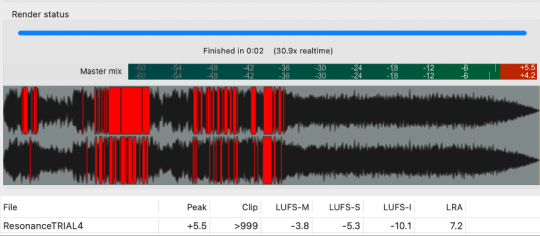

I fixed all the clipping that can be seen above in red by bringing the track’s volume down by 5.55db because the peaks were +5.5. This sounded much better.
However, there is still a very noticeable constant high frequency buzz. I’ve been trying to remove it but I’m finding that it may just be an inherent attribute of having the wet param at the level it’s at. When I’ve tried to bring down the gain on a range of frequencies using ReaEQ it also took away the sound that the high wet param (in the ReaVerbate FX) brings. I may leave it as is.
Rotoscoping is SUCH a slow process i feel like hours just go by and I look at my 7 second clip; thinking i'll learn nuke for next semester, surely theres a faster way than After Effects RotoBrush because this is ridiculous.
0 notes
Text
HMsEx Blog Entry 10
Reaper Progress
At the beginning of the first clip there’s about 2 seconds where the camera is focusing, I thought this would be a suitable time to implement a simple EQ envelope to give a sense of the audio becoming clearer in tandem with the video. I was inspired by the way both sound and light are distorted when submerged in water giving that nice audible change in clarity when emerging from water. As you can see below, I marked the point that the video becomes in-focus and made a “fast end” incline on an EQ – Gain envelope starting at -40dB.
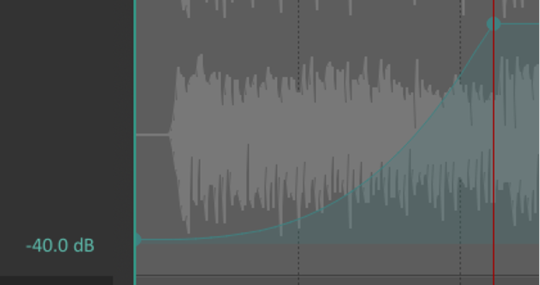
EQ - Gain Envelope

While camera is focusing
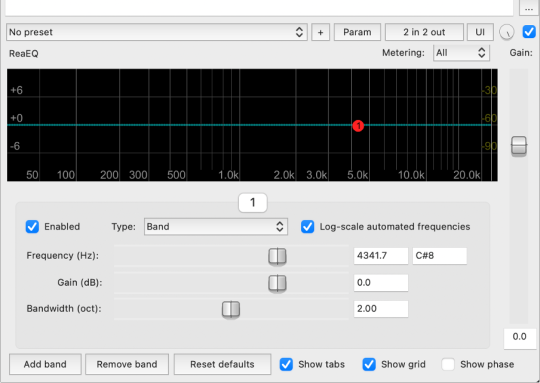
After camera is in focus.
Later I brought a draft of the first 25 seconds of my liminal exhilaration vid into reaper so that I could view It as I essentially keyframed the reverb effect’s many parameters. I placed markers at all the end of each clip and keyframed the reverb parameters to change based on the visible size of the space. E.g. the brick wall museum sign shot which is the only one that doesn’t have obvious empty space in the background had a smaller roomsize (parameter) and was dryer, with the intention of indicating closeness and smaller airspace. So far, this change looks noticeable and logical without being too abrupt.
I’m starting to quite enjoy manipulating the music, I might start to do this with my own edits once the semesters over. Before that I have a ton of rotoscoping to do, which I’ll use the RMIT computer labs to do because it’s simply too slow on my macbook.
0 notes
Text
HMsEx Blog Entry 9
I feel as though it’s time to recap and further strengthen my reasoning behind why my project Liminal Exhilaration, is truly exhilaration. When talking with my interviewee Lucas after the interview about how I believe that some type of exhilaration is what this unarticulatable feeling is, he immediately disagreed which was quite refreshing for me to hear. Although I was slightly distraught, it was obvious that he attributes exhilaration to the factors that are generally “hyper/high energy”. Funnily, when trying to then explain how there are other factors like heightened focus, I referenced the flow state which he then immediately thought of the “in the zone” type of Flow that psychology articles often use to describe Flow in colloquial terms; appealing to the general public. So basically, I tried to explain two things that have highly under-attributed definitions…
RECAP: Exhilaration is inherently liminal, its only different from excitement because the experience plays on the threshold of danger. Liminal Exhilaration primarily involves Joy and Heightened State of Mind as we received an overwhelming amount of contrasting emotions like: uncertain but not threatening, feeling familiarity in places you've never set foot, you're exploring but not looking to find anything, you're taking it all in at once but can be focusing on and valuing the beauty of particular things as you pass them. Liminal exhilaration is not about explicit vigor, motion, display of high skill, speed or intelligence, it’s the cognitive overload of playing on these emotional thresholds in the multilayered sense, that Liminal Spaces offer.
Colour Grade So far
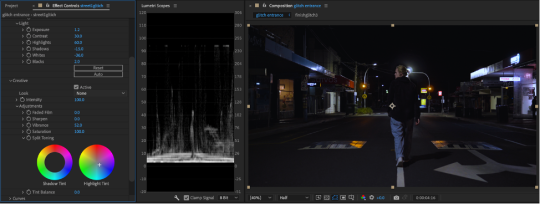
Instead of adhering to a rigid and uniform colour grade for all four clips, I've chosen to prioritize the aesthetics of each individual scene. By tailoring the colour grade to suit the distinctive lighting and atmosphere of each clip, I've harnessed the power of colour to evoke the essence of these enigmatic transitional spaces, allowing them to evolve and resonate with their inherent emotional nuances. This creative departure not only enhances the visual impact of the project but also adds an intriguing layer of complexity to the narrative, mirroring the fluidity and ambiguity of liminal spaces themselves.
0 notes
Text
Blog Entry 8
Sound Design: Resonance – HOME
I’ve decided to go with Resonance by Home, the song that got me hooked on Schyguyy and, in turn, this whole aesthetic. The song I said I’d use before was Memory Reboot but now I feel like that track is too in your face and exciting; I like how neutral Resonance is, it makes the vibe less attributable to one emotion, the uncertain, the unclear, and the undefinable is the essence of liminality.
Research - Technical

I’ve used Reaper to essentially do what time remapping does in Premiere Pro for video, but for audio. Pressed alt T to bring up the tempo envelope, and made 3 BPM keyframes (90, 100, and 120, 120 being the song’s normal tempo) with the second transitioning to the third linearly. I did this because I couldn’t choose between the different popular versions of Resonance, sometimes I like Resonance slowed (.9x) + reverb, other times I like super slowed (.75x), but most often I like the original.
Sidenote: I believe many people who’ve listened to this song and songs like it feel the same; remixes of songs being as popular or more popular than the original appears to be positively correlated with Phonk’s popularity (my personal observation).
I looked for ages trying to find out how to remap the time of an audio clip, something that I thought should be simple as it is for video. I asked google, YouTube, chatgpt, nothing. Finally through clicking different “audio item timebase” options I found a solution that no one else on the internet recommended.

“Beats (auto-stretch at tempo changes)”
Before setting this, Reaper was playing the whole track at the BPM of the last keyframe (120BPM, the track’s original tempo) despite the tempo envelope’s time remapping between 90, 100, and 120. All sorted now.
I’m still fiddling around with reverb, thinking I might even try to keyframe particular parameters so that the sound either starts out sounding far away and low clarity and becomes encapsulating and clear, or vice versa.
Research - Academic
Zuckerman Interview video on genetic basis of sensation-seeking.
“Well, this is determined from twin studies called Biometrics of Behavior Genetics actually. Using these twin studies we initially found that roughly 60% inheritability. In heritability is the proportion of the variance in a trait that is determined by genetics. We discovered there was 60% -- which is very high for a personality trait which generally runs between 30% and 50%. So, 60% is high for a personality trait.” (Zuckerman 2009).
He goes on to talk about a particular dopamine receptor gene having existed in our species for, not all evolution, but around 50,000 – 100,000 years. He says that because analogues of sensation seeking expressions or approaches to novelty in other species linked to the same biological indicators that humans have, this is more than just an analogy, it indicates it has evolutionary history.
So, I could potentially have some visuals that come up displaying evolution as a potential cause of this ability to have a dulled fear response that gives the individual the rewarding satisfaction of completing a dangerous task.
Research - Creative Practice
Looking some examples of good Reverb and how it started out. King Tubby was a prominent figure in the Jamaican soundsystem culture of the 50s. His sound engineering work was pivotal to the creation of reggae and dub in the 60s & 70s; apparently, he’s known for basically creating the concept of remixing!
His modest use of reverb is present on the snare, it’s very noticeable.
“One of Meek’s most famous techniques was using different reverberant spaces in his studio and house for recording instruments with natural room sound—like under his staircase or in his bathroom.
Listen to the different kinds of spaces he creates with various reverbs, especially the uniquely spacey reverb on the backup vocal line: ‘I Hear a New World.’” (Trandafir, 2022).
Feedback on Videos Week 8
Last Train Edit:
Harry
What’s the mood or style?
Reminds me of JDM car core, where people show off their cars at night time in minimal lighting.
When you see this kind of video where it looks lonely or only has one subject, do you find it creepy?
In the context of how you’ve edited the video, no. But you could, the space itself is not inherently dangerous or creepy, so the space alone isn’t creepy. More aesthetic than uncanny. And the music is not creepy, sort of peaceful almost.
Lucas
What’s the mood or style?
Quite moody, feel like that song is often used in tiktoks with beauty in them or representing something emotionally motivated or trigger emotions. So that sort of paired with the color grading and the style of the video, creates this real almost reflective feeling.
2.When you see this kind of video where it looks lonely or only has one subject, do you find it creepy?
Nah, more of a feeling of beauty. It’s like the “are you lonely I can’t fix that” blade runner moment, soft. I can’t explain it really, I’d have to think about it for a moment. It’s like standing in the rain but you're not cold and your mind is clear and you’re just there. I can’t put it into words, not static not uncomfortable not creepy not warm it’s just yeah. It’s like a version of the sublime.
Carpark Edit:
Harry
I like the composition; I like how all the yous overlap.
What’s the mood, style, or emotion provoked?
Feels busy, there a lot more going on; busier. Makes me feel relaxed. Really like how it’s layed out, it’s very satisfying. Feels quiet even though there’s music. I like how the pole is in in the right third. However, you running at the camera right at the end, is a large contrast to the vibe before that; the mood and seriousness kind of changes. Really liked the environment, you leaning against that pole alone makes you acknowledge the empty environment. These environments are really interesting cuz it doesn’t look like how I imagine Australia looking.
2. When you see this kind of video where it looks lonely or only has one subject, do you find it creepy?
Perhaps the setting itself is more uncanny. If it was just one you leaning against the poll and no rotos it’d probably be creepier and uncannier. So having all those rotos there takes that potential creepiness away.
Lucas
What’s the mood or style?
Crazy how much sound design affects the vibe cuz that one feels way more stranger things. 80s vibes. I feel like that fits in with the aesthetic. Quite a similar feeling until the end running part that parts quite different adds this urgency to it where the whole rest of the video doesn’t. Totally changed the overall feeling. That running was pretty violent, I don’t think it suits at all, even is slowed down (slowmo) further.
2. When you see this kind of video where it looks lonely or only has one subject, do you find it creepy?
No. I feel like it’s like same sort of video as a guy sitting out the front of a 711 smoking a cigarette and listening to music at like 1am feeling content; It’s an in-between, beauty of the in-between of the suburban lifestyle. Kid that has to wait for a train for an hour cuz the next train doesn’t come for an hour and you’re just sat there waiting, not in a rush cuz you can’t make it come any faster.
Takeaways:
More human presence appears to take away that creepy/uncanny potential
Off centre positioning of large/noticeable objects may be an effective technique, satisfying. e.g., when there’s just me leaning against a large electricity pole in the right third of the frame, and nothing else to see except the environment.
Peaceful
A feeling that is hard to articulate, "reflective feeling" "version of the sublime" "Your mind is clear and you're just there"
The running rotoscope of me breaks the immersion and the feeling; I will not be doing this again.
(McLean, 2023) (Horta, 2023).
I want to make the point that with just a slight change of the human presence and music, the video could become creepy and uncanny; this reminds me of how exhilaration works, it often straddles the threshold of excitement and fear. Essentially, everything ties in as this description of exhilaration is liminal in itself, i.e., occupying a position at or on both sides of a boundary or threshold (being the boundary of excitement and fear).
Works Cited
Big Think and Zuckerman, M. (2009) ‘The Genetic Basis of Risk-Seeking’, Big Think.
McLean, H.M. (2023). Interview by Rory Henderson, hmsex2023-rorys3965039, 16.09.2023.
Horta, L.H. (2023). Interview by Rory Henderson, hmsex2023-rorys3965039, 16.09.2023.
Trandafir, L. (2022) 8 songs that belong in the Reverb Hall of Fame, LANDR Blog. Available at: https://blog.landr.com/8-reverb-examples/ (Accessed: 15 September 2023).
0 notes
Text
Blog Entry Week 7
40 Second Liminal Exhilaration Video Plan (Half Way)
00:00 – 00:05 Displaying 4 empty suburban liminal spaces, me getting off the train or getting out of the train station, putting my earphones in and pressing play on the song Memory Reboot

00:05 – 00:10 I start appearing across these spaces with a glitchy/blurry entrance making it look like I’ve spawned in (representing the feeling of entering the state of liminal exhilaration being random and sudden)

00:10 – 00:13 In line with the beat, the back ground appears to change around me, using match cuts
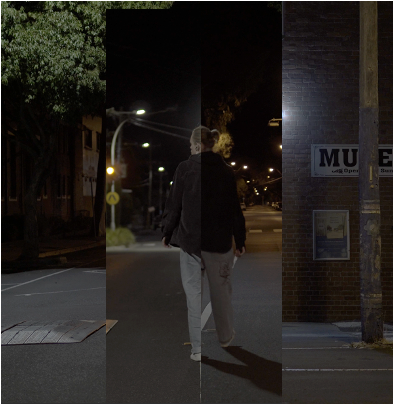
00:13 – 00:17 Rotoscopes of me start to appear around the environment as the centre me continues to walk.
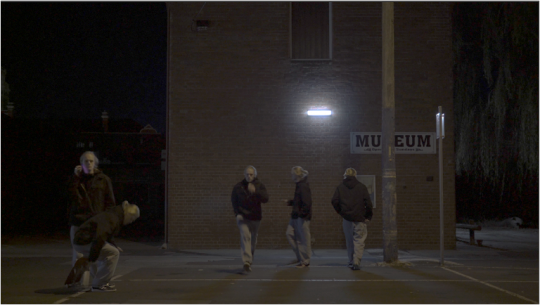
00:17 – 00:20 The running rotoscope me will (in the centre) will be the focus and will run faster/get closer and closed as the music builds towards the drop.
Reflection
I’ve been thinking about changing the first five seconds because the spaces on their own lack and narrative hook. As there will be a scene of me putting my earphones in and playing music before the beat drops displaying me in a bunch of these spaces, I’m thinking it’d be better to have shot of me exiting the train station or the train itself to provide context. To use Schyguyy as a reference, who just the other day hit 300k followers on Instagram, all of his liminal space videos start with him in the space. None of them are empty, which arguably makes it more comfortable. The liminal space analysis from Scrabbl in the last entry inferred that the presence of people directly affects liminal space imagery, removing the creepy or uncanniness, unlike horror imagery where it can be creepy either way. I.e. Putting a person in a typical “liminal space image” could end up just looking like a photo from the 90s; not abnormal or weird, yet maintains underlying features present in liminal space imagery such as the graininess, colour, exposure, etc. Thus, I believe my presence in the video will work similarly to Schyguyys in removing the creepy, uncomfortable feeling while maintaining liminal exhilaration.
Progress: I’m slowing down, I’ve acknowledged this but am yet to get serious again. Not sure what’s brought this on. Oh well back to it.
Academic Research
Zuckerman 1970
This personality survey discerns four distinct types of sensation seekers: individuals in search of adventure, those desiring novel experiences, individuals seeking to break free from inhibitions, and those prone to boredom. Those who seek adventure tend to engage in physically daring activities, typically sky diving or base-jumping (at the time of the study). People seeking new experiences may be drawn to exotic destinations or experiment with unfamiliar cuisines. Individuals seeking removal of inhibitions forge new social connections, while those susceptible to boredom frequently crave novelty. Zuckerman's research demonstrates that many individuals exhibit traits from multiple categories, yet the ultimate reward remains consistent, thrill.
Sensation Seeking Scale (SSS) was developed in addition to the four subtypes of sensation seekers described above.
High sensation seekers pursue the fleeting feeling of thrill or exhilaration
Low sensation seekers actively avoid thrills and new/unfamiliar experiences
Most people fall around the middle of this scale, relating to factors such as brain composition and chemistry, hereditary factors, and “tolerance for exhilaration”(The Atlantic).
Skateboarding and the concept of thrill seeking goes against Sigmund Freud’s Pleasure Principle of how humans seeking pleasure and avoid pain to satisfy biological and psychological needs. One may argue this isn’t worth mentioning because “thrill seeking activities” have only been popular in the last half century or something like that. However, the following study shows research on the genetic association of sensation seeking, inferring that such traits were also present long before popularity of thrill-seeking hobbies. Important reminder that the four subtypes of sensation seekers involve very different contexts, but the effect/feeling is the same.
Heritability for sensation seeking ranges from 40% to 60% (Eysenck, 1983; Fulker, Eysenck, & Zuckerman, 1980; Hur & Bouchard, 1997; Koopmans, Boomsma, Heath, & van Doornen, 1995).
Further research into heritability looks at specific dopamine genes that are associated with sensation seeking. “Our results indicated that dopamine genes are associated with sensation seeking at the system level, that is, at the level of multiple SNPs in multiple dopamine genes. This systems approach had the ability to account for nontrivial variance; 3.9% (corresponding to a correlation of 0.20) of the variance in sensation seeking was explained using only 12 SNPs. Given a heritability of sensation seeking of 58.3% (Fulker & Eysenck, 1980), we were able to account for 6.6% of the heritable variance in sensation seeking. However, our sample was not of sufficient size to allow for cross-validation, and so this effect size estimate may be reduced when replication is attempted. Nevertheless, model fit indices demonstrated that significant independent variance was accounted for by the inclusion of multiple SNPs.” (Derringer et al. 2010). Over all a very interesting study, feel free to check it out here. However, as stated above the effect size estimate is small and results of the study aren’t generalisable at this time. Other studies on dopamine receptor (DRD4) genotype provides evidence of its role in novelty seeking, one of the sensation seeking subtypes, during adolescence; https://pubmed.ncbi.nlm.nih.gov/17076753/ , however it’s not generalisable to all genders, effect was only seen in males.
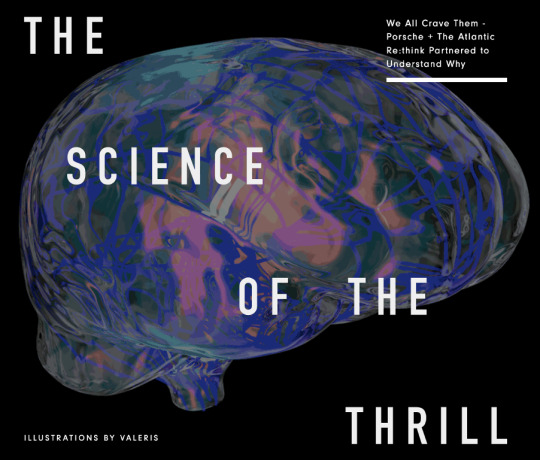
Skate fear psychology video NEEDS to get filmed this week or next.
REASON I haven’t filmed it yet is due to lacking a clear plan of the progression of the video so let’s make that clear now.
Plan for Fear Psychology Video:
Shot of a skater about to do his run up for a trick down a stair set (close up of his face, showing determination in his eyes)
Close up of the throw down (a form of getting on the board with speed)
45 degrees shot of skater rolling towards the stair set, normal speed.
In the last metre before the stairs, it becomes slow motion to the point where time fully stops the camera whips around and goes into his eye
From the eye it we enter the mind of the skater
Starting at the amygdala releasing a combination of chemicals including adrenaline, dopamine, and endorphins. Dopamine has many functions, including telling us that there is a potential reward if the registered threat is overcome.
Testosterone streams into the body boosting general strength potentially increasing chance of success.
Adrenaline simultaneously increases heart rate, increase oxygen intake sends oxygen throughout the body which is then rerouted to the brain asap.
Then we come back out of the skater’s brain and time resumes, then showing him successfully doing his trick down the stairs.
Similar Works Analysis:
Animation by NSS3221, a TikTok account that posts astronomy related short videos. 33 million views, 4.2 million likes.
Starting by displaying the solar system, the planets orbiting the sun on a 2d plane with text saying “What most people think our solar system looks like”, a viewer is naturally intrigued as they are concerned that they may be part of the supposed majority who the video is inferring is wrong; on top of this the song used is METAMORPHOSIS by INTERWORLD so you already know the algorithm’s loving it. This animation shows something that people already have a brief understanding of, the solar system, and expands on that to a degree that is interesting and engaging, but not overwhelming (information wise).
“Theory of Relativity (E = mc2)” edit
Once again, it’s a video that starts by showing a concept that anyone who’s had a high school education has heard of at some point, and then expands on it using text and visuals. However, this example is a bit overwhelming and hard to follow because the text + cuts are too fast; multiple images and pieces of text appearing at once, no time to take in the information and actually have an understanding. Nonetheless, this 24second video got 318k likes and 1.7m views.
The Great Filter Edit – 54.2k likes 388.2k views
This edit, unlike the solar system one was actually really interesting and informative. It has a voice over as well as music (and captions). Compared to the previous two, this actually taught me a new concept; or rather, explaining actual theory behind something that everyone may ponder at some point and providing a term that’s used to describe it. I never knew there was a term for the supposed reason for a phenomenon so broad like “why is humanity alone in the universe?”. This is a 45 second video.
Works Cited
Derringer, Jaime et al. “Predicting sensation seeking from dopamine genes. A candidate-system approach.” Psychological science vol. 21,9 (2010): 1282-90. doi:10.1177/0956797610380699 https://www.ncbi.nlm.nih.gov/pmc/articles/PMC3031097/#:~:text=Sensation%20seeking%20is%20a%20heritable,reliably%20linked%20to%20behavior%20disorders.
Laucht, Manfred et al. “Visual exploratory behaviour in infancy and novelty seeking in adolescence: two developmentally specific phenotypes of DRD4?.” Journal of child psychology and psychiatry, and allied disciplines vol. 47,11 (2006): 1143-51. doi:10.1111/j.1469-7610.2006.01627.x
The science of the thrill (no date) The Atlantic. Available at: https://www.theatlantic.com/sponsored/porsche-2016/the-science-of-the-thrill/1010/ (Accessed: 18 September 2023). Zuckerman, M. et al. (1964) ‘Sensation seeking scale’, PsycTESTS Dataset [Preprint]. doi:10.1037/t03439-000.
NSS [@nss3221]. Our solar system is moving with an average velocity of 514495 miles per hour (828,000 kilometers per hour). But even at this speed, it takes about 230 million years for the Sun to make one complete trip around the Milky Way. TikTok, 07.02.2023, Accessed at https://www.tiktok.com/@nss3221/video/7197359888908045594?is_from_webapp=1&sender_device=pc&web_id=7258431136622806530
zonez__ [@nowankashi]. Earth. TikTok, 31.01.2023, www.tiktok.com/@nowankashi/video/7194747080122846466?q=science%20edit&t=1696066928768.
naty ☆[nikolai.ae]. when the science is sciencing. TikTok, 09.04.2023. www.tiktok.com/@nikolai.ae/video/7219761441874644229?q=physics%20edit&t=1696065849191.
0 notes
Text
The Last Train 末班车
to try on my instagram and Tiktok this coming week.
Techniques: scale up keyframes, masking, mask path keyframing, suitable text.
0 notes
Text
Blog Entry 6
Cymatics video
This was a really cool example that represents audio visually in ways I’ve never seen before, some of it was unbelievable. I thought of designing this sort of thing in Blender but these guys have just done it with nature. I believe this video could be almost exhilarating. The voice over is a brilliant edition. I found this video completely immersive. This video uses an exceptional buildup; when he takes off the black sheets and his hood and you see that all the people there are him. Then they put on these nuts’ executioner chainmail and fucking turn on a mfing tesla coil like WTF now we see homies chainmail conducting electricity like damn how crazy is that. This was a very impressive piece however if I were to try and analyse it from an audio focused perspective I’d struggle because this piece has such immersive audio visual synchronis which I believe has a bias towards the visuals; which is completely fine of course but it may slightly distract us from the title of the piece being Science vs music which supposedly entails an equal battle between music and the “science” based visuals.
OH MY GOD Automatic was actually better than Cymatics I think, or just different. It was good at the interesting at the start but the middle when the robots started to speed up and move absolutely flawlessly. Then when the robots supposedly became autonomous but still wanted to include the human, I thought this was absolutely epic. Unlike what Darrin and Nick thought, I liked this absurd destruction that the human just accepted as it happened around him; I felt as though the video was set up well enough to make all these things fathomable. For example, the laser was shown at the beginning and appeared to be a real thing, same with all the other robots; as I was watching them in the beginning, I was thinking jeez is this real, if their parameters are off by an inch the whole instrument will be destroyed. This amazing precision really makes it unreal and consumes our focus. Because of this, we can assume exhilaration initially comes from high focus and amazement (likely some combination of the happiness and heightened state factor). Later, it could be argued that the exhilaration is more generic, following that lit excitement factor when robots are becoming sentient, it could even tie in with secondary factor of fear/risk briefly before they throw him the guitar and want him to jam with them. At this point it’s a nice combination of excitement from the action, danger, and music building up, and then happiness through seeing our main character getting the outcome of being chosen to be included by the robots instead of consumed by the havoc they were wreaking. HOWEVER, upon reflection I don’t like the ending where you get the idea that he’s been a robot/connected to them the whole time because it means that happy theme of human-sentient robot peace is gone.
Techniques of Maintaining Engagement
Reveals what has been hidden the whole time
Introduces new complex and slightly dangerous looking machines by pulling off black sheets that were covering them
Destruction
Sudden narrative development (Robots becoming more and more capable and then sentient)
Research - Academic
Fear Psychology – Nautilus Article

Mental Rehearsal
“Honnold keeps a detailed climbing journal, in which he revisits his climbs and makes note of what he can do better. For his most challenging solos, he also puts a lot of time into preparation: rehearsing the moves and, later, picturing each movement in perfect execution. To get ready for one 1,200-foot-high ascent at the cutting edge of free soloing, he even visualized everything that could possibly go wrong—including “losing it,” falling off, and bleeding out on the rock below—to come to terms with those possibilities before he left the ground.” (Mackinnon 2016).
Honnolds journal keeping is the act of memory reconsolidation; reconsolidation adds new information and/or alternative interpretations of consolidated memory, fearful memories can be reconsolidated into less fearful or fearless ones.
“Revisiting memories to cast them in a new light, Monfils says, is almost certainly something that we do all the time without being aware of it. But doing so actively, as Honnold did, is better—“a beautiful example of reconsolidation.” (Mackinnon 2016).
She then speaks on Visualisation which happens before memory consolidation (before the event or action). You picture a future event.
“’It’s better over time if you can put yourself in a situation where you experience some fear, but you overcome it, and you do it again and again and again,” Monfils says. “It’s hard, and it’s a big investment, but it becomes easier.’”
For many skateboarders including myself, visualization is common; I like to imagine myself landing the trick before trying it (if I’m struggling, for the first try I don’t tend to use visualization). I also talk to myself a lot but it’s mainly harsh motivation with lots of swearing at myself. There are some clips where you can see the skater about to attempt something very difficult and dangerous and they scream or yell something before doing it. Screaming is known to activate the amygdala, however that wouldn’t make sense in these events of them screaming and then landing the trick. Here are some reasons that might be making it work for skaters
Psychological Priming: Screaming may psychologically prepare individuals for the impending challenge. By vocalizing their readiness or determination, they may psych themselves up and increase their confidence, which can be crucial when facing something scary or risky.
Catharsis and Release of Tension: Screaming can serve as a form of catharsis, allowing individuals to release pent-up tension and anxiety. When facing something frightening or risky, the body's natural response is to experience heightened physiological arousal, including increased heart rate and muscle tension. Screaming can help discharge this built-up energy, making it easier to cope with fear and anxiety.
Physiological Response: Screaming triggers a physiological response in the body, including the release of endorphins, which are natural painkillers and mood elevators. This can create a sense of euphoria and exhilaration, helping individuals overcome their fear and commit to the activity.
Arousal Regulation: Screaming can help individuals regulate their level of arousal. In extremely challenging or dangerous situations, the body may enter a state of hyperarousal, which can impair decision-making and motor skills. Screaming can serve as a way to modulate this arousal, making it easier to focus and perform effectively.
Research - Creative Practice
*All use of “liminal spaces” in the following analysis are referring to liminal space imagery.*
Other Opinions and Outliers in Liminal Space Classification
Youtuber, Scrabbl, summed up a few common definers of liminal spaces:
Transitional
Designed context removed (e.g., a mall that isn’t full of people or a highway with not a single car)
Combination of the above
His idea of transitional spaces is more constrained than mine; I find this insightful. For example, this viral image of a living room that has no furniture. Scrabbl says “you wouldn't call a home a transitional space; maybe in the grand scheme of things but not in the traditional sense.”.
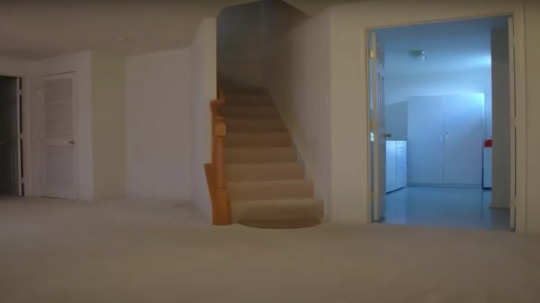
Rather, it’s the removal of the context this space was designed for that makes it a “liminal space”.
When I was thinking about why I disagreed with this as soon as I heard it, I reminded myself not to mistake developmental for transitional. However, I feel that Scrabbl acknowledging transitional aspects but overall disregarding them is closed minded. I believe developmental spaces are inherently tied to and/or make up transitional spaces; after all, development in any sense isn’t just one linear, connected, path, there are transitions. Thus, I believe that the home, a long-term space of development where many people end up before and after one of the most major transitions in life (child to adolescent); perhaps the “moment” of transition that we may internalise is not the home, but the fact that the space of the before and the after is consistent makes this relationship interrelated if not interdependent.
He then shows us a couple of outliers:

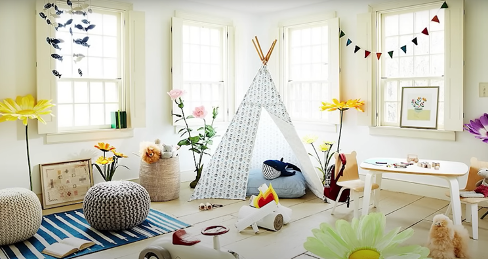
He says this basement is neither transitional or had its designed context removed from it, yet we still consider it a liminal space. He says one may claim “oh but the kids aren’t present in the play space so that’s why it’s liminal”
He says “fair” and presents this. He says this image we may typically see in a furniture catalogue doesn’t feature kids playing in it when that very much appears to the purpose of the space, i.e., context removed to the same extent as previous example, yet we wouldn’t consider this a liminal space. His point is that defining liminal spaces isn’t that simple. He says when we see an image of a liminal space we don’t stop to classify it using the aforementioned definers, we just feel it. He believes that we should define liminal spaces based on the feeling associated with them, rather than the physical traits or the way the feeling is produced.
He also believes we shouldn’t define spaces solely on the definition of the term liminal (this is very insightful to me because this has been a major factor leading me to classify which spaces I consider to be “truly liminal” and which are just cliché misattributions to the term “liminal space”).
Therefore, he attempts to define liminal spaces using the only two physical traits consistent across all liminal spaces:
Presence of manmade structures
Absence of people
AND
Always a combination of UNEASYNESS and FAMILIARITY, varying in which is more dominant.
He then goes on to identify methods of achieving the atmosphere that gives liminal spaces that unique feeling combination (above):
90’s and Y2K aesthetic (time period many internet users grew up in) providing sense of familiarity
The above also provides a sense of weirdness coming from:
Overload of colours
Graininess
Yellow light
Low Quality
He says darkness typically associated with fear, creepiness, and negative feelings but he used only one example:
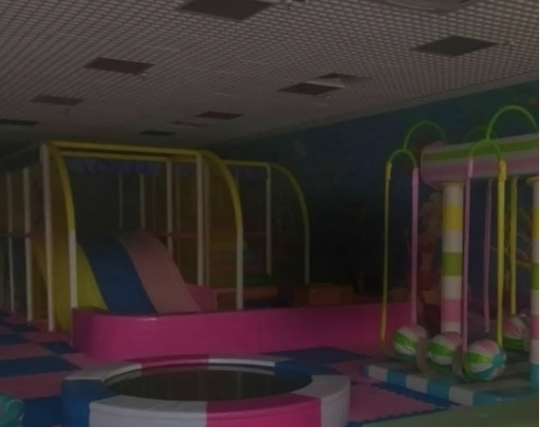
In this image, it’s arguable that the light is just as important as the darkness; the light is from the flash or a torch, giving this first-person feeling, its scarier being reminded that this photo was taken by a person in this creepy dark indoor playground opposed to lighting that is less related to the position of the camera/photographer.
I actually have much more to explain on the reasoning for WHY some liminal space imagery gives a certain feeling but I could go on for ages, best be concise or keep some for next entry.
He goes on to explain why they can be comfortable. He says that liminal spaces can be relatable or at least they were for him when he was particularly down and didn’t have anyone to talk to (or even just didn’t feel like talking to anyone). Emptiness, sorrow, disorientation, loneliness, he saw in them what was happening in himself, he felt understood by the images. The combination of these feelings, the relatability, and the nostalgia embedded in these images, made him feel at ease. “Have you ever wondered why liminal spaces feel so empty? It’s because you’re supposed to fill the void, to escape reality even if it’s just for a brief moment, and explore a world where you and your feelings are completely free.” (Scrabbl 2022).
CONCLUSION: he made great points about why liminal spaces (liminal space imagery) give us a certain feeling. He spoke too much on negative feelings and generally speaks to the audience only from his POV of finding them comfortable when he’s really sad or stressed or sick of life, but that isn’t relatable for me at all; I do feel that freedom he talks about but not for the same reason. I don’t directly notice similarities between liminal spaces and negative emotions (even if I was feeling them on that day), I’m far too immersed in the exhilaration. I believe this has something to do with the fact that I’m physically IN liminal spaces that are accessible and he’s just looking at a folder of images of those really cliché ones; altered, edited, purpose-made. It’s becoming clear that “liminal space imagery” and liminal spaces are two very different things and that frustrates me.
Research – Technical
Glitchy entrance effect
youtube
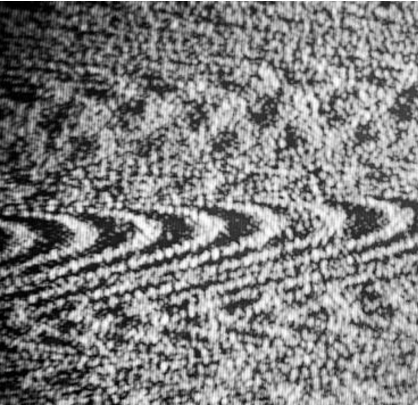
I used this tutorial, very conveniently this is very close to what I had in mind. Their glitch effect is a bit more blocky but I wanted mine to look more wavy like an old tv in between channels static thing.
Here’s the result:
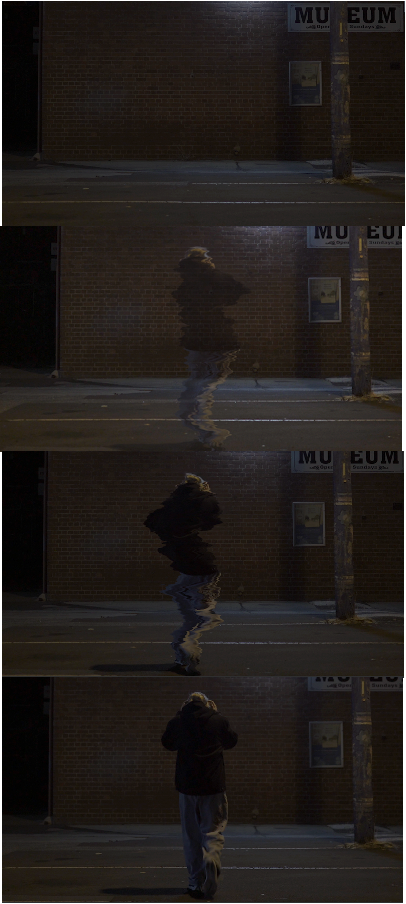
Still might adjust it a bit but looks good for now. Good thing about this is that it’s really easy for me to apply it to other masked clips now that I’ve made it once. It used a solid with fractal noise added to it which is then linked to the masked clip using displacement map.
Works Cited:
Mackinnon J.B. (2016) The Strange Brain of the World’s Greatest Solo Climber, Nautilus website, accessed 25/08/2023. https://nautil.us/the-strange-brain-of-the-worlds-greatest-solo-climber-236051/
Scrabbl (2022) The Comfort of Liminal Spaces (and The Desire to Disappear). Available at: https://www.youtube.com/watch?v=t9OgLEUjz_g (Accessed 26.08.23).
KYLER HOLLAND (2018) After Effects: Disconnected Glitch Effect!. Available at: https://youtu.be/-WOLWXnlSso (Accessed 29.08.23).
0 notes
Text
HMsEx Blog Entry 5
Started editing my Liminal Exhilaration footage of streets and train tracks near my house. Tonight, I’ll go out again using a faster lens because my other lens does not perform well in low light. There was a lot of noise on all the clips and colour correction was quite difficult. However, after looking back at the nature of liminal space imagery, noise is a consistent part of the majority of the images; somewhat tying in with the method of giving the image a “washed out” look, covered in the last entry.
I shot in two image profiles, standard mode and “sunset” mode which made things look very warm and orange; I’d never used the image profiles on my camera before but I think next time I will definitely just stick to standard because now I have to colour grade the warm orange ones differently when I’m already very happy with my colour grade for the standard clips.
I recently found the name of the genre of music I’ve been loving so much recently, Synthwave.
Songs for Liminal Exhilaration:
Memory Reboot – VOJ & Narvent
Night Drive – Timecop1983
After Dark – Mr.Kitty
The Perfect Girl (The Motion Retrowave Remix) - Mareux
Research - Academic
The Psychology Podcast hosted by Scott Barry Kaufman – Steven Kotler chat
Scott made a very interesting point when discussing a recent finding he’s made in a paper to do with the 6 dimensions of curiosity in trying to predict creative achievement in life. He said he thought the dimension of joyous exploration would be the biggest predictor; he said that to their surprise they found that the biggest predictor was thrill seeking. Furthermore, he said that looking at the items on the thrill-seeking curiosity questionnaire they made, that the most common items were to do with the “thrill of mastery”. He didn’t get further into this but just hearing that quite interested me. Coming back to what we discussed the other day, about whether that exhilaration of landing a trick can really come through doing something you’ve done before, I believe this is very reassuring, even though Scott’s talking about curiosity, in the larger scheme of things they were talking about predicting creative achievement. Especially as Darrin made good points on how typically we never feel as elated as when we achieve something for the very first time, this finding of thrill of mastery a motivator for creative achievement to be very much in line with my personal experience, having this drive to perfect my practice, landing something for the first time will feel great but what’s the point if I can’t add this trick to the handful that I can confidently every single attempt, down stairs. So, here we see this constant of achievement, but also a further desire for mastery; I’m very happy this podcast has helped me articulate this because the other day in our conversation I couldn’t quite do so. The mastery that proceeds the first achievement is actually what drives the achievement in the first place, the whole art of skateboarding has always been based on this drive to hone our skills just as those more experienced that we’ve seen before us, seeing their fluency, consistency, and style that they take to every single pop of the tail. That drive is what keeps me hooked, I’m in it for the long run, I’m not here to land it once and then put it on the backburner, I need to own my tricks.
Research - Creative Practice
Principles & Methods for Achieving a Flow State | Voices w/ Vervaeke | John Vervaeke & Kevin Bowers
It’s interesting to hear discussion of the Flow State in that true “in the zone” sense, as in your completing a task with familiarity and ability. This is indeed a very common form of flow but not one that I’ve thought about much when thinking of my Liminal Exhilaration project however it is good that I’ve revisited this as it has decent relevance for my Skate Fear Psychology project. John and Kevin discuss achieving a flow state in a creative sense, to produce creative work and seemingly unblock paths that have been blocked for some reason. This idea of unblocking is very similar to the way that extreme sports enthusiasts view fear; where the average person may see fear as a relevant block that shouldn’t be tampered with.
“I want you to remember this feeling guys, like right now, you feeling it?” – Kevin Bowers
It sounds like Kevin does some really great work that allows people to become conscious of the flow state and what it feels like. This is essential for us to better understand and label the feeling of this state. Having common understanding is the first step towards collectively articulating what exactly the feeling is. However, the inherent subjectivity of exhilaration is a concern; or perhaps this notion is the issue in itself? Is exhilaration truly subjective or is it simply that no one has been able to provide a comprehensive ruleset for what can be deemed as exhilaration? This obviously questions more largely, are all things subjective simply waiting to be made sense of with objective theory, or rather, were all things objective once subjective? Quite perplexing.
Research - Technical
I watched some simple refresher videos on using Rotoscope and proceeded to mask out all my selves from one clip of a car park near my house. This was going well until I went in front of a dark background (I was wearing a black hoodie). Here’s a look:
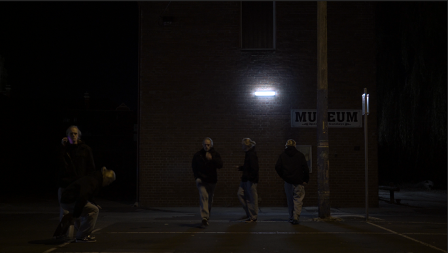
Issues:
In case rotoscoping wasn’t time consuming enough, I have to mask the shadows on the ground and deal with their overlapping which seems hard to be precise with but so far it looks fine.
Didn’t colour correct beforehand, not sure if that’s detrimental or not but should be fine to do it afterwards; I’m just wondering whether it would’ve made rotoscoping easier or not.
Exhilarating Project 1 - Skate fear edit
In contact with my work mate Jesse Brodbeck; he’s a sponsored skater, very experienced and skilful. Organising a day to go filming with him. I’ll make a story board or video plan for that video next week.
Exhilarating Project 2 – Liminal Exhilaration
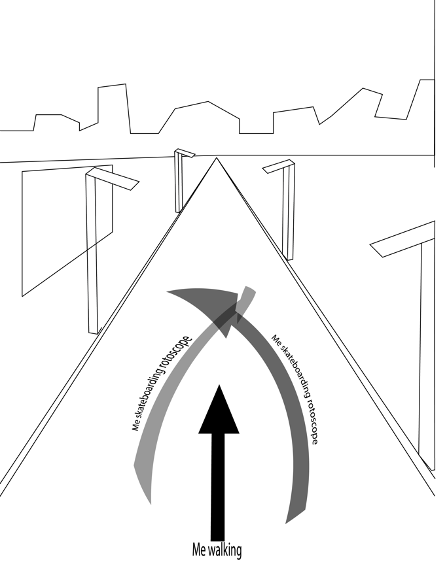
Plan for a shot – There’s this really long footpath that runs along the train line that I skate along on my way to and from Mentone train station. The trainlines on the right and fences of houses on the left. The sketch below is just an idea of the motion that I’d display. Me walking down the centre at a normal speed while rotoscopes of me skateboarding along this road in a sort of snakey 8 shaped pattern are slowed and overlayed.
In many of Schyguyys videos he uses this technique of displaying many of himself moving in the one static environment. This has many implications:
Displays the how one can get lost in the moment while in these spaces, not acknowledging the passing of time. Him occupying multiple areas in the space in just a few seconds (displayed simultaneously) gives us a sense that he is fully in the moment in each position he’s in (similar to flow state) but is obviously moving somewhere and time is passing in this uncontrollable but nonchalant nature.
It’s also generally an unreal and interesting visual effect.
At this point, this effect has been seen many times by most social media consumers so it won’t be too shocking or unreal.
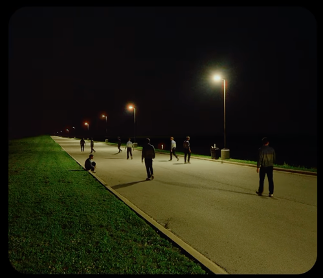
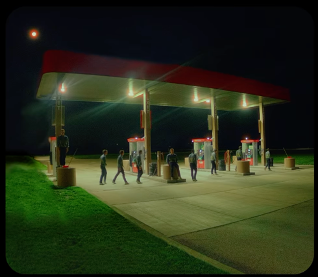
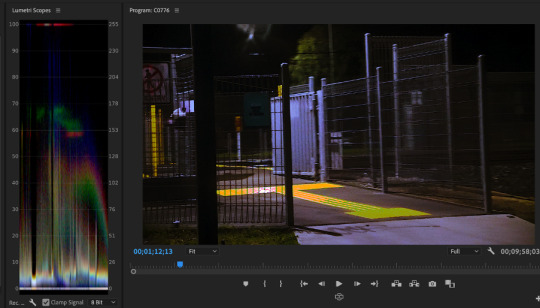
I’m really happy with my first colour grade. A lot of liminal space photography and videography is done with early 2000s or even 90s cameras which give it a “nostalgic” feeling. However, for Gen Z, this shouldn’t be the case; but we still do find that footage like that or footage edited to have more grain and old-school saturation nostalgic or reminiscent in some way, likely for a slightly different reason to millennials.
The result of my colour grade displays the clarity that modern cameras can film and the old school/Y2Kish look commonly used to give a dream-like affect in media today. In a way I believe this is a better choice than just using an old camera because it keeps things looking real and current. I want the viewer to not so much reminisce of the past while in a liminal space (viewing one) but rather be in the present with a subtle nostalgic comfort clouding the mind. This balance of the old and new is liminal in itself. Perhaps liminality is some sort of spirituality I’ve yet to research. We quite often hear “Don’t dwell on on the past” or “focus on the future” when talking about negative experiences, which often annoys me as I know they’re just way to comfort someone and make them feel better. It’s becoming more and more apparent to me that Liminal Spaces are not just liminal because of the cognitive attribution to a transitional/developmental phase (e.g., Streets from age 9-17), they can contain myriad forms of liminality.
My shot displayed above is liminal through the transitional phase attribution, the aesthetic is between real and unreal, and the use of new equipment and but old style is inherently liminal as well.
Let’s focus in on why this is Exhilarating.
We are already aware that exhilaration is not objective and that many people have likely internalised a limited meaning of the word; typically, just a further extent of exciting.
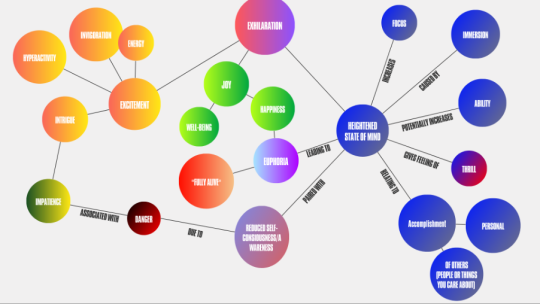
The stylistic choice of having the old style on the clarity of modern video cameras was made through considering how exhilaration without narrative motivation usually needs to make the viewer or experiencer feel as though they’re the present; if the footage looks too unrealistic or unrelatable we won’t easily feel it. Whereas with maintaining the dreamy nostalgic style with the clarity of modern cameras I believe the exhilaration will come more smoothly.
There’s usually some sort of progression to Schyguyys videos. If I want to make my video 40 seconds long it needs a narrative. Some of Schyguyys earlier videos had no narrative, the video that led me to follow him was one of these. Seamless match cuts and Synthwave baby! https://www.instagram.com/p/CkbA8FOA5gf/ So, it’s clear that not having a narrative works for a certain amount of time it’s just unclear how long that is. I’ll have to look further into it.
Heres a little snippit of my rotoscoped mes' doing their thang.
Works Cited:
Kotler, K. Kaufman, S.B. (2023) The Psychology Podcast. [Podcast]. 23 February 2023. Available at: https://open.spotify.com/episode/1YYXQvD4uyU9dzTqxrxu3M?si=PalNPOqrRS6Mw3U1XojL1A&context=spotify%3Ashow%3A4POIiQQjnQOuz0AqnLk3KZ&nd=1
John Veraeke (2022) Principles & Methods for Achieving a Flow State | Voices w/ Vervaeke | John Vervaeke & Kevin Bowers. Available at: https://www.youtube.com/watch?v=iteirgNDKrg
0 notes
Text
HMsEx Blog Entry 4
HMsEx Blog Entry 4
At the beginning of Week 4 I set up a plan using Microsoft office planner; I’ll use this to set short-term and long-term goals and check them off once complete.
I was quite happy with my pitch. I’ve never had a course with two lecturers before but I’ve been really enjoying the disagreements on some topics or experiences that Nik and Darrin comment on. The feedback I received was great, hearing Darrin’s opinion on the skateboarding psychology idea possibly being too informative or information driven. In that moment I totally understood, it was a risk I thought of beforehand as well. Then, Nik’s feedback telling me that using a narrative to drive the experience would be a good base for the information to sit on, and nicely maintain engagement. Very useful stuff that’s given me a lot to think about, thanks guys.
Research - Academic
Fear Extinction
A fundamental process within the realm of psychology and neuroscience that involves the gradual weakening and suppression of a conditioned fear response. This phenomenon occurs when an individual is repeatedly exposed to a previously fear-inducing stimulus in a safe and controlled environment, leading to a reduction in the fear response over time. The process of fear extinction is closely linked to the brain's ability to form new associations and rewire neural circuits, facilitating the gradual replacement of fear-related memories with more adaptive and less distressing ones. Understanding fear extinction has significant implications for treating anxiety disorders and trauma-related conditions, offering insights into therapeutic approaches aimed at diminishing irrational and debilitating fears.
What I’m concerned with is how one diminishes rational and reasonable fears; does it involve more than typical fear extinction?
Self – Affirmation Interventions
Positive Self-Affirmation Statements: Individuals create and repeat positive affirmations about themselves and their abilities to counteract negative self-perceptions.
Visual Reminders: Watching yourself do a trick on flat ground and thinking about the feeling of landing that trick is a method used for mentally preparing yourself to do that trick down something big/scary (Collins)
Self-Affirmation Exercises: Personal favourite, if I’m about to do a trick on some obstacle or terrain I’m not entirely comfortable with I’ll do it on flat ground as clean as I can, directly before my run up for the obstacle; this gives me an umph and a reassurance.
Social Affirmation Statements: Seeking and appreciating positive feedback and validation from friends, family, or mentors (Sherman & Cohen 2006). I can confirm that there have been a number of times where I’ve been greatly motivated by skater’s superior to me and have landed tricks that I otherwise wouldn’t have attempted. In Suzhou, where I started skateboarding, there was this one OG (mid 30s skater) who is the owner of a skateshop and skatepark. He always told me that he thinks I’m on the right track to getting sponsored, and as I know how skilful of a skater he is and can only imagine how good he was in his prime, I really valued his words. He always let me in his skatepark for free. When we’d go out together at night for a street session with other shop/park homies, his presence and instruction motivated me like nothing ever has before. He’d see some wack obstacle that the whole group would’ve just walked past and say “Yo, jump down that.” In a very chill manner. So, I’d get up sceptically and think like “damn I don’t know about this” but for him and the homies I had the confidence to at least give it a shot. Social affirmation statements, verbal or not, have lead me to do some of my best skating.
“The first couple techniques Collins mentioned are things that skateboarders already do, like working up from easy to progressively more difficult tricks, or getting positive affirmations from friends. Collins also agreed that taking a slam could be a good way to get over your nerves. “You might call it the Dr. Pepper argument. Like, what’s the worst that can happen?” he said, referring to a slogan Dr. Pepper uses in the UK.” ( NOTENS & COLE KOMMA)
What is a “Liminal Space”?
Streets are commonly regarded as “liminal spaces” as seen through edits on social media.
I didn’t truly understand the meaning of the word I’ve been using to describe places that give me this exhilaration. On social media the way “liminal spaces” in speak never explains what makes these spaces liminal or even what the word liminal means; we’ve just put a title on a place that gives us a feeling.
Both these definitions are relevant:
“1 occupying a position at, or on both sides of, a boundary or threshold: I was in the liminal space between past and present | the paintings in this exhibition are the result of recent investigation into liminal states.
2 relating to a transitional or initial stage of a process: that liminal period when a child is old enough to begin following basic rules but is still too young to do so consistently.”
(Oxford Dictionary of English).
The Street as a Liminal Space – (Hugh Matthews 2002)
Matthews observed that time spent on the streets was an important part of the day for much of youth is. The word street is broad, it can mean “out and about”, outside of the home or a friend’s home.

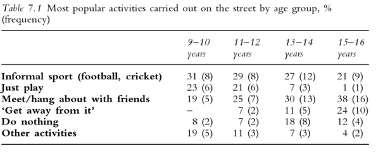
For many kids the street is the only place where they can meet informally; unlike adults who have clubs, pubs, residences, etc.
“As such, streets are places where adultist conventions and moralities about what it is to be a child that is, less-than-adult - can be put aside. They are spaces that are temporarily outside of adult society, particularly with the withdrawal of adults at particular times of the day (Sibley 1995), fluid domains or a thirdspace set between childhood and adulthood, where the process of separation can be played out (Matthews et al. 2000c). Within these interstitial spaces young people can express feelings of belonging and of being apart and celebrate a developing sense of selfhood. In essence, therefore, streets can be grouped among those places where the newness of hybrid identities, no longer a child not yet adult, may be articulated (Rose 1995).”
(Next paragraph not crucial but interesting potential way of understanding why some people may consider some spaces liminal where others wont)
“Yet here is a cultural dilemma, for whilst streets appear to offer freedom away from adult mores, occupancy of the public domain is rarely uncontested, particularly when young people come into contact with vigilant adults who are not prepared to relinquish their overarching control. In order to remain on the street, therefore, young people carve out their own cultural crevices, and create their own social fissures. Often these are places where adults are not commonly found: in this study children regularly congregated in back alleys, on derelict land, around lock-up garages, at the rear of shopping parades, in pockets of green space within neighbouring scrub woodland, in essence, within the forgotten and redundant spaces of the adult world.” (Mathews 2002)
Now if we refer back to Liminal’s oxford definitions earlier we see through Matthews’ reasoning that neighbourhood streets are inherently liminal.
Research - Creative Practice
Definition of the Liminal space aesthetic:
Schyguyy’s videos are exemplars of what I call Liminal Exhilaration. His most recent video really hit me with how I must look when I’m walking home at night and staring up at starry skies or dim street lights. https://www.instagram.com/p/Cv0C7EBNi0F/
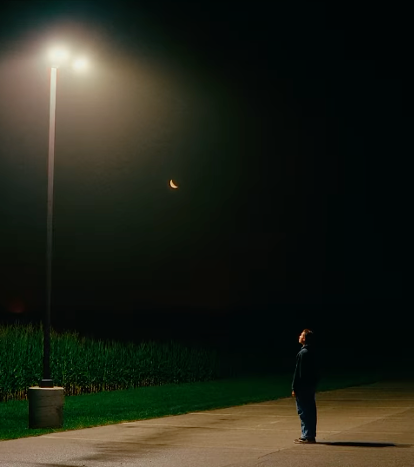
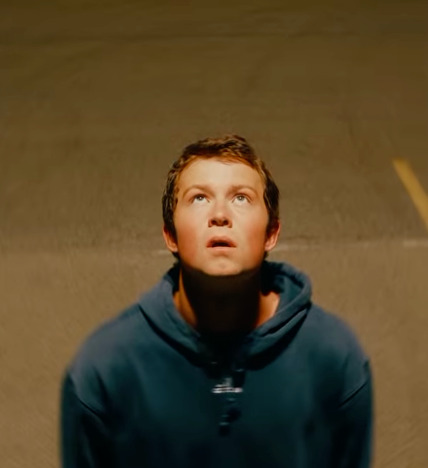
Look at his face. This is how I imagine I look when starring up at nothingness. It’s this somewhat voluntary (I wouldn’t say deliberate) relaxing of your face muscles which often feels mindless, thoughtless and consumed by the simplest sensory stimuli like an infant.
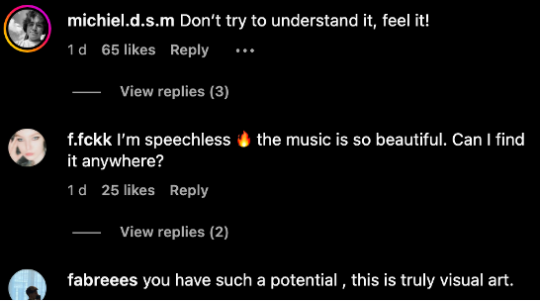
Here are some comments. They wrap up what I feel for his work quite well. This kind of exhilaration is not the type that makes you say “oh my god” in excitement; it’s better enjoyed through feeling rather than comprehension.
In the eternal seas of narrative or “meaning”-rich content we’re drowned with today, one can stand up and realise that the understandable is merely a pool we’re addictively submerged in.
In a citadel, high above the slums sits aristocrats who find beauty only in the glisten and shine of gemstones; comfortable in the instant gratification palace of their own incarceration, they will never come down and appreciate the beauty in what wasn’t made to be beautiful.
Although very woke, the above is how I feel about a lot of content on social media and its viewers who’re stuck in the scroll.
Research - Technical
The Use of Color in Liminal Spaces – Shookey
Shookey’s Youtube video on his methods of determining what makes a space “liminal”.
“Liminal Spaces are art. No matter what the medium may be. Because of this, artists will make efforts to frame or shape said mediums to make them actually feel Liminal.” (Shookey 2021)
Monochromatic Colour
Always having a clear standout colour can make an image that looks real feel fake or unnatural.
Contrast (Between colours, shapes, or light)
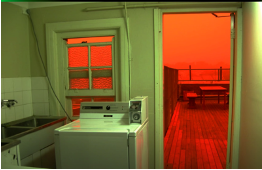
Red outside this laundry room gives the feeling of danger. This is a literal contrast from the relatively normally lit and coloured inside, to the outside which looks as though it may be day time but with an unnatural red haze. The only time this would be visible in reality is supposedly during a dust storm, however, he say’s that in liminal space imagery this could be something much worse.

He says the lighting outside has either been altered or naturally balanced with the inside, so the contrast is not with inside-outside light but with the blue and purple. Purple gives feelings mystery and the unnatural.
Washed
This method is likely most useful for my project and the type of liminal spaces I want to display.

These examples have all been the uncanny side of “liminal spaces” that I still have to classify as “liminal” because of the fact that they play around the boundary of the real and the surreal. The above image is bizarre in how there is almost nothing visible other than this exit sign. The exit sign points to the fog but staying on the same path leads to fog as well; other than that, the exit sign is strangely lacking in information, no distance, no name, just exit and an arrow. This type of contrast is between the clear and unclear, ironically making the clear subject very unclear in a figurative sense. This technique could be very useful in controlling the viewers focus, hopefully in a way that can add nostalgia. Even though the exit sign’s meaning isn’t clear, the creator has utilized a very recognizable and understandable object to be the subject; I too will pick out objects that our brain has strong existing neural pathways to. However, my choices will not merely be recognizable objects amongst a bleak background (because almost everything today we see we have seen before) but objects shapes or environments that many people have attributed memory to.
I want to be able to make the viewer feel like they’ve seen this before, like they’re getting back part of a memory.
The type of liminal spaces I want to film are empty locations of our childhood (like streets as proven earlier) described as having an elegiac aura. Because video creators refer to this aura as particularly saddening, I will chose spaces that have general relation to childhood or adolescence but aren’t obvious; this way I hope to evoke that feeling of familiarity, to provide comfort, but not the eeriness of seeing your childhood memories in such empty lifeless states.
Exhilarating Project 1 - Skate fear edit
Just been thinking about how I might film this. I want the video to have this interesting 2d platform to it. It’s obviously 3D but the camera keeps the subject in the centre of the frame and at the same angle, requiring the camera to move exactly as the subject does.
Exhilarating Project 2 – Liminal Exhilaration

Exhilarating Project 3 - Upside-Down People
Still discussing.
Works Cited
Collins, D. 2019, THE SCIENCE BEHIND OVERCOMING FEAR IN SKATING [Interview], Jenkem Magazine with Nic N & Cole K.
Christensen, P.M., O’Brien, M. and Matthews, H. (2002) ‘The street as a liminal space’, in Children in the city: Home, neighbourhood and community. 1st edn. Abingdon, Oxon.: Routledge.
Sherman, D.K. and Cohen, G.L. (2006) ‘The Psychology of Self‐defense: Self‐affirmation theory’, Advances in Experimental Social Psychology, pp. 183–242. doi:10.1016/s0065-2601(06)38004-5.
The Use of Color in Liminal Spaces (2021) YouTube. Available at: https://youtu.be/xza58OeSSYo (Accessed: 01 August 2023).
0 notes
Text
Exhilarating A1
Exhilarating A1

This is a mind-map displaying my current understanding of exhilaration.
Here are the primary factors of finding something exhilarating:
Joy - exhilarating’s latin route meant joy or cheerful, the earliest meaning of exhilarating was “to make cheerful” (Marrium-Webster)
Excitement - This is the high energy, further extent of excitement aspect some of us may typically associate exhilarating with.
Heightened State of Mind/Flow State - Easy form of exhilaration is to watch someone who is experiencing exhilaration themselves, e.g. being in the flow state, a state of absolute focus on the task at hand through displaying impressive ability and familiarity, and confidence in ones own skill. commonly reported as being an exhilarating experience.
Some secondary factors:
Fear to Stress to Thrill - Generally speaking, there are a number of physical indicators that stress and exhilaration share; such as, increase in heart rate, dilation of pupils,
Euphoria - Fully alive
Impatience or intrigue
Invigoration
Focus
Immersion
I believe that exhilaration is always a combination of at least one primary factor with at least one secondary factor.
Personal experiences of exhilaration in the past few years are often a joy - euphoria - invigoration mix. This is what I feel when skating home in empty streets late at night with music in my ears. My recent favourite song that creates this exhilaration when paired with the night skate home is called After Dark by Mr. Kitty. I feel alive and free in these moments.
My projects will encapsulate the great diversity of exhilaration described in this Tumblr. Opposed to focusing on one or two common forms of exhilaration, exposing the viewer to the type of experiences that they may not internally label as exhilarating as well as ones they do, will provide them with a comprehensive insight into the subjectivity and interrelatedness of the many primary and secondary factors of exhilaration.
KungFu Panda
The main character initially appears goofy and is the underdog and and the climax of the narrative is truly exhilarating as we’ve:
Gotten to know Po and his upbringing as someone obviously adopted and different from all the other villagers; he has dreams but isn’t likely to become anything other than a noodle chef like his father.
We see his struggle and desire for something more in life
We see him being selected by pure luck and coincidence as the dragon warrior; the absolute disapproval of the Furious Five (his new peers) and his new sensei
We then see his hard work and effort reminding us of his impressive noodle shop table waiting we witnessed at the start of the movie.
At the climax we see him do what is meant to take one years and years to master; the underdog has triumphed and surpassed his peers who had all the more opportunities and experience in this field.


The nobody - the chosen one transformation is a great basis of many narratives. In this instagram video we see someone who looks like nobody special and then we are shocked by this huge contrast. Essentially, this video does what the above description does but to a smaller scale. Simply showing the character as nobody/underdog and then showing them as the master paired with good music dynamics can make a source of short-term exhilaration. Let’s acknowledge the major difference; will I remember this video for the rest of my life, definitely not. Will I remember KungFu Panda for the rest of my life, absolutely. Nonetheless, this was an exhilarating video by my definitions at least.
Avengers Endgame
youtube
I recall this moment when I saw this in the cinema and it is certainly an experience I’d describe as exhilarating in the sense that, I’ve seen more than 3 previous Avengers films over a number of years, I undoubtedly care about the characters and their goals. The exhilaration was more dependent on long-term narrative development both in and outside of the cinema. I believe that having cliff hangers and being forced to wait for the next movie to come out arguable keeps the story and characters in our mind over a long period of time. I’ve never been a big marvel fan but I’ve no doubt developed that care that’s necessary in providing a highly exhilarating moment in a triumphant/comeback scene like this. I’d say it’s comparable to barracking for a sports team; one doesn’t cheer, cry, or scream their lungs out in cheer or excitement for a team they don’t care about, it’s years of consistent association that creates that experience. From my perspective, the care I felt for the characters in this movie was very much sub-conscious; nonetheless, it was consistent. I believe this consistent presence was crucial for the care factor.
Back To The Future
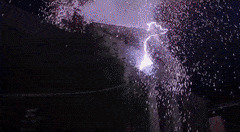
Back to the Future has very similar climaxes in all three movies. Here, the exhilaration is from fear of the characters not accomplishing their goal. Once again it's a case of caring for the character and their goals that make the build up to the crescendo exhilarating. However, compared to the Avengers example, this one has a more detrimental time restraint. I believe time restraints are a crucial factor in exhilarating experiences; this goes for both the restraints on the characters time to achieve their goal, and the time in reality the viewer has to observe this event. For the viewer, the restraint of time may feel like "if we aren't dedicating 100% of our focus to the task at hand or the thing we're watching, we might miss the climax completely" which is almost a sense of forced engagement. This type of exhilaration is no doubt entertaining; however, the forced nature of putting the audience in a heightened focus using time constraints doesn't meet the creative standards I intend to produce my projects with.
Quantum Levitation in 60 Seconds
An animation by Eduardo Piñones
https://rmiteduau-my.sharepoint.com/:f:/r/personal/s3965039_student_rmit_edu_au/Documents/HMsEx%20A1%20RORY?csf=1&web=1&e=6qOz5z
This video on a topic that the average person probably wouldn’t be that interested in by its name, includes a high quality animation with a very trendy song with a great drop (and Chinese subtitles). This video originally had a voiceover explanation but the creator on Douyin replaced that with the song METAMORPHOSIS by INTERWORLD and used a subtitle explanation instead. My Chinese isn’t at the level of understanding quantum physics terminology so I can’t understand all that much but I’ve watched these types of edits before that take a complex topic that I’d usually not wanna watch a video on and then make it very interesting.
Brilliant song choice shows primary factor excitement and secondary factor intrigue. The song’s drop at the start acts as a great hook and works really well with the time ramping down of the animation.
Displaying a phenomenon naturally causes us to focus in order to comprehend what we’re seeing; this is primary factor Heightened State of Mind and secondary factor immersion as the imagery and subtitles with the mesmerising music comes together to require all of our focus as we see that this is a video to be taken seriously.
Are you afraid, Mr White? (Gustavo Fring - Breaking Bad Edit)
This Gustavo Fring edit is purposed with showing the antagonist in his most badass moments.
We see a progression of events that are crucial in the plot. The protagonist, who was becoming very successful, is reminded of who runs the show and what he’s capable of; we feel shock and fear. This was edited in synchronism with the music which provides an audio-visual link. As the music builds up or gets silent our anticipation of what happens next is affected; I haven’t heard this song before so my anticipation of the nature of the following clips (which we can see to be linked to the tempo of the music) is inhibited, this adds to the exhilaration through thrill and intrigue of the unknown. Thus, even though I’ve seen Breaking Bad and know what happens, I was exhilarated, through the blurry nostalgia and the editing technique; I was fully focused, didn’t want to miss a single frame. I’m not kidding when I say this edit gives me shivers, even though I’ve watched it so many times.
Gustavo Fring is one of the greatest antagonists ever, played exceptionally by Giancarlo Esposito. He is the definition of a wolf in sheep’s clothing. The contrast between his calm collected public persona and his monotone, impulsive, murderous, drug boss character is what strikes fear deep into the viewer’s heart.
My favourite VFX skate edit ever - @Lynnwakeup @Rogue (Douyin)
https://rmiteduau-my.sharepoint.com/:f:/r/personal/s3965039_student_rmit_edu_au/Documents/HMsEx%20A1%20RORY?csf=1&web=1&e=6qOz5z
This edit shows a mix of the great skill of the skateboarder Rogue and the visual effects artist Lynnwakeup. The initial flickering between psychodelic, glitchy aesthetic clips are intriguing but what had me hooked was the final clip before real life footage comes on, where its this open hand with tiny skateboards rolling onto the palm coming from the wrist.
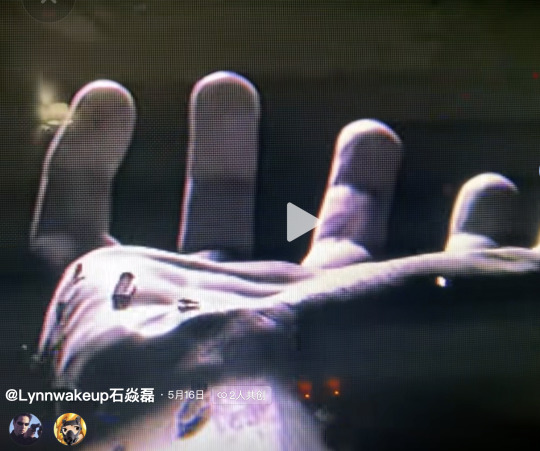
This eery animation had me in awe, a great prepper for the amazing VFX entangled skate tricks to come. The first trick comes, quite impressive but the beat drop is still coming and we see this freaky transition. Shown us so much so far we’re intrigued and in a heightened state of mind/focus, the beat drop is what we’re in it for and we start to feel that exhilaration as the clip comes in with this amazing transition that I’ve never seen in any VFX skate edit before.
Unfortunately, the exhilaration was slightly killed right when it was meant to be put on full throttle. The trick the skater does is very impressive however the matrix-esque background replacement was too distracting and I couldn’t focus on the trick. This may not be an issue for non-skater viewers.
I believe everything up until that point was great build up that could lead to sustained memorable exhilaration.
@A panacea ’s Thrasher: My War edits
https://rmiteduau-my.sharepoint.com/:f:/r/personal/s3965039_student_rmit_edu_au/Documents/HMsEx%20A1%20RORY?csf=1&web=1&e=6qOz5z
This account uses the exact same editing format and song for the majority of its videos; using videos from Thrasher Skateboarding Magazine’s YouTube playlist “My War”. For context, the My War playlist includes the often literal blood sweat and tears behind some of Thrasher Magazine’s most amazing cover photos; viewer’s hear the skater speaking of what was going on in their mind and what the homies or filmers were feeling at the time. The documentary or biography-esque style of the videos on YouTube paired with this one song that A Panacea uses intrigues us with the information/story and then really hooks us as we start to hear the song coming to its crescendo, before it drops the music goes silent and we see the clip of the skater landing this legendary trick and that drop is so rewarding as we see the cover photo with the iconic Thrasher Magazine title.
The beat drops and I’m left staring in awe at this static photo for a few seconds with the music going, often a tear comes to my eye.

This use of having that silence before the payoff is a powerful technique as we desperately want to see the finale; its power is in that silence before, it can be viewed as a cleansing of the pallet before showing us something that demands our full admiration.
This explores secondary factors accomplishment, thrill through ability, focus, intrigue, impatience, and danger.
teamLab Borderless Shanghai
While most of the rooms in this great immersive experience were more mesmerising or calm, there was one long room that used sound, light and haze to create an exhilarating experience. The walls and ceiling was covered with these strobe or spot lights that appeared to sit on a ball joint as they could turn in many directions very smoothly. If there wasn’t the upbeat sound aspect and bass(there were massive subwoofers in this room which you could feel the vibration from), this likely wouldn’t have the excitement/heightened wakefulness aspect that differentiates exhilarating from awesome. The lights when on and off and changed direction in tandem with the rhythm and tempo; with the haze, the light beams (fully visible and distinct) often crossed each other making all kinds of incredible shapes.

Walking through the hallway to my room with the lights off at night
Guided by only the faint moonlight/streetlight visible through the translucent glass element of our front door, most nights I try to walk from the living room to my room (our house is a long rectangle haha, my room is closest to the front door and the living room is half way down the house). This is an example of very short-term exhilaration. The primary factor being heightened state of mind leading to secondary factor of thrill. The darkness creates a sense of unfamiliarity and risk; as we’re so dependent on our eyes for information. Furthermore, the lack of almost any other sensory stimulation likely adds to this sense of unfamiliarity and lack of control which gives me that thrill that leads to exhilaration. However, its worth specifying that I choose to walk through this darkness; there are lights I could turn on before walking if I wanted to. I believe the fact that I feel comfortable in this space and have voluntarily thrown myself into almost complete darkness is what allows me to find this thrilling (exhilarating) and not just fearsome and stressful.

Urban and Nighttime Environments
Feeling exhilaration or a sense of adventure during a nighttime walk is a natural response influenced by the interplay of environmental and psychological factors. The darkness and reduced visual input create an aura of mystery and novelty, heightening curiosity and anticipation. The break from daily routines and the opportunity to explore an unfamiliar nighttime environment evoke feelings of excitement and discovery. This emotional response is further fuelled by the release of dopamine, contributing to the overall enjoyable and refreshing experience of a nighttime walk.
“Given the subtle changes being made to our cities, as well as the constant demands on our attention, it may be seriously questioned whether most of us have the time or inclination to engage with a sense of place anymore. But out there beyond our homes, an alternative, liminal habitat awaits us in the nocturnal city.”
“Rather than being daunted by the penumbra of the built environment, walking into the night can be a refractory act against the restraints of daily chores; a means of dissipating the heft of familiar roles and responsibilities. Even in those parts of the city with the greatest light pollution, the absence of people can be a strange and exhilarating experience. This is when we are most able to engage all our senses with the city.” (Dunn 2016).
Main Character Syndrome and the adventure and novelty seeking tendencies
Main Character Syndrome refers to a psychological phenomenon where individuals perceive themselves as the central characters of their own life story. They tend to exhibit adventure and novelty-seeking behaviours as they seek to create a more exciting and fulfilling narrative for themselves. By embracing new challenges and seeking novel experiences, individuals with Main Character Syndrome strive to craft a unique and exhilarating life journey, reminiscent of the thrilling adventures portrayed by protagonists in stories and media.
I don’t appreciate this new term “main character syndrome” because its used too broadly; different people seem to consider different behaviours indicative of main character syndrome. For example, my ex girlfriend told me she overheard a mutual friend at a party saying that she looks like she’s got main character syndrome as she was dancing more and visibly enjoying more than those around her. Obviously, my perspective is biased but from my understanding she doesn’t try to do more or be more esctatic than others, she just feels that those around her aren’t lit and she’s doing what makes the party more enjoyable for herself which is dancing with the enthusiasm she does.
Whereas what I find indicative of main character syndrome is where someone acts in a way that is comical, laughably comical but does so unironically with full seriousness. https://www.youtube.com/shorts/qk8w4sBAjhM
Works cited
A panacea (12th December 2022) ‘滑手Milton Martinez’ [Douyin video], A panacea, accessed July 29th 2023. https://www.douyin.com/user/MS4wLjABAAAAGLErKORP_fVBDpGoMuhAa05mlII7h3K0zjETnl0vHQg?modal_id=7180172916988988724&vid=7201726315202907448
Dunn N (18 November 2016) ''When streets become supernatural': the joy of walking in cities at night’, The Guardian, accessed July 29th 2023. https://www.theguardian.com/cities/2016/nov/18/nocturnal-night-city-nick-dunn-streets-supernatural-joy-walking-cities
“Exhilarate.” Merriam-Webster.com Dictionary, Merriam-Webster, https://www.merriam-webster.com/dictionary/exhilarate. Accessed 4 Aug. 2023.
GBYANG(混剪)限流王 (23 July 2023) '绝命毒师古斯塔沃炸鸡叔:Are you afraid, Mr White、’ [Douyin video], GBYANG(混剪)限流王, accessed July 29th 2023. https://www.douyin.com/user/MS4wLjABAAAAIUzH8HcejQ3cbQT_qKoS3_bhkGXo6Pdm81J0glRF5xY?modal_id=7258153813561888040&vid=7258153813561888040
Lynnwakeup石焱磊 and Rogue (16 May 2023) ‘“回到街头。“‘ [Douyin video], Lynnwakeup石焱磊, accessed July 29th 2023. https://www.douyin.com/user/MS4wLjABAAAAwNL_jGyISIPz6b995C6zvxKcNqfT0MIYGjaH8PvY6iA?modal_id=7233727047766445347&showTab=favorite_collection
Piñones E (23 June 2023) ‘Quantum Levitation in 60 Seconds An animation by Eduardo Piñones’ [Douyin video], 阿物科普, accessed July 29th 2023. https://www.douyin.com/user/MS4wLjABAAAAYMTGo7kHhm7p06jgiKoEDbfnI6LwSO3E8QruuTyi3ZA?modal_id=7247824873161084216&vid=7247824873161084216
przmoney (12 February 2023) ‘Life is a W rn’ [Instagram Reel], przmoney, accessed July 29th 2023. https://www.instagram.com/reel/CoiVmydP22d/?utm_source=ig_web_copy_link&igshid=MzRlODBiNWFlZA%3D%3D
1 note
·
View note
Text
HMsEx Blog Entry 2
Tuesday - Woman in distress video
Techniques
1st part
Insanity trying to sound sane and keep the person on the line
Yellow and orange light makes the scene look sick and dirty, old
Lights shut off cleansing our pallet to then receive slightly more calm and collected dialogue in a different language
Later cut off but darkness seemingly mid sentence, as though the phone line has been cut; however, the sound accompanying this blackout is not a line cutting sound, rather an echoing electric laser like sound. Prompts the question: Is this phone call real? The environment isn’t realistic, it quite literally depicts a broken home
Alternately, the phone cut off with that non-realistic sound may be depicting danger ⚠️ especially in pair with the blackout. It feels as though the one hope of survival has now been cut off and she’s left in the darkness with some other evil presence.
2nd Part
Cool light but still dark
Strobing
Lots of noise, actor struggling to speak over the noise and intensity
More fear
3rd Part
Less cold light more neutral and well lit
Shows how she
Past trauma causing her to reenact the chokehold her supposed husband had her in
Extreme strobing
Data collected by the senses
Total 1.1 meg vs 16-40 bits
- Collected - Conscious attention
Every second
sight 10,000,000 bits, skin/feel 1,000,000 bits, hearing 100,000 bits, smell 100,000 bits, taste 1000 bits
(Norretranders 1999: 121)
I’ve never thought of the senses capacities as metrics before. It’s interesting to have a way of viewing their capacity numerically but even more interesting to know that we can devote conscious attention to only 16-40 bits. I take this new information as a reminder that the subconscious mind is, despite imperceptible, a powerhouse. It also puts into context almost everything we’ve looked at so far in this course; the subconscious constantly has input on our emotional responses to things happening in the present. An aroma that you’ve over years unknowingly attributed to a place, person, or action; leading us to suddenly find ourselves reminiscing due to a smell that chemically has no connection to our physical being. It opens up pathways of manipulating audience experience through the senses, something I’ve rarely looked into in the past. This also makes me question how valuable conscious attention really is.
Flaw with objectives
Setting objectives almost certainly inhibit their achievement
“suggesting the strange conclusion that some problems are best solved by methods that ignore the objective.”
“The main lesson is the inherent limitation of the objective-based paradigm and the unexploited opportunity to guide search through other means.” (Kenneth O. Stanley, 2011)
I found this actually unbelievable but I’m assuming that’s because of my lacking understanding of the AI program they built and the aesthetic nature of database it draws from. I don’t have much else to say about this topic because I struggle to see it in the context of my own life.
Research - Academic
Fear Response
When an individual encounters a threat or danger, the amygdala, a key structure in the brain's limbic system, plays a crucial role in processing fear-related stimuli. The amygdala rapidly evaluates the sensory information and triggers the fear response, including physiological changes like increased heart rate, sweating, and heightened alertness. Furthermore, the prefrontal cortex modulates the fear response, allowing for cognitive regulation and inhibition. Studies by LeDoux (2000) and Phelps (2006) have extensively explored the neural circuits underlying fear processing, providing valuable insights into the brain's intricate mechanisms during fearful situations.
Fear Extinction
This study explored the role of the medial prefrontal cortex (mPFC) in fear extinction. The researchers found that specific neurons in the mPFC signalled memory for fear extinction, which suggested the involvement of this brain region in inhibiting fear responses after extinction learning.
Research - Creative Practice
Although this isn’t exactly creative practice, it is an HME; it has a target audience who it’s geared towards, it has immersion, and intention like all other HMEs.
Powers, M. B., & Emmelkamp, P. M. (2008). Virtual reality exposure therapy
This meta-analysis examined the efficacy of virtual reality exposure therapy (VRET) for various anxiety disorders, including specific phobias and social anxiety. VRET is an innovative method that allows individuals to confront their fears in a controlled and immersive virtual environment, facilitating fear extinction and reducing anxiety.
Insta Saved Videos
I find use of trendy music with often obvious beat drops to be quite exhilarating and can really emphasise contrast like in this video where the social media influencer shows his average looking vlog videos where he looks like a goofy funny kinda guy captioning “me on social media” and on the beat drop switches the caption to “me at work” and to clips of him modelling and catwalks with some of the biggest fashion companies in the world. His entire look has changed as the perspective is now that of an industry level catwalk videographer. We see his stature that was not visible during his vlogs and his admirable physique as well as his exceptional cheekbones emphasised by that monotone model face. https://www.instagram.com/p/Cq5dOTXNqUj/ Calumharper18
Here’s a comment that shows the average viewer response:

I believe this is exhilarating because similar to many fictional movies, KungFu Panda for example, the main character initially appears goofy and is the underdog and and the climax of the narrative is truly exhilarating as we’ve:
Gotten to know Po and his upbringing as someone obviously adopted and different from all the other villagers; he has dreams but isn’t likely to become anything other than a noodle chef like his father.
We see his struggle and desire for something more in life
We see him being selected by pure luck and coincidence as the dragon warrior; the absolute disapproval of the Furious Five (his new peers) and his new sensei
We then see his hard work and effort reminding us of his impressive noodle shop table waiting we witnessed at the start of the movie.
At the climax we see him do what is meant to take one years and years to master; the underdog has triumphed and surpassed his peers who had all the more opportunities and experience in this field.


The nobody - the chosen one transformation is a great basis of many narratives. In this instagram video we see someone who looks like nobody special and then we are shocked by this huge contrast. Essentially, this video does what the above description does but to a smaller scale. Simply showing the character as nobody/underdog and then showing them as the master paired with good music dynamics can make a source of short-term exhilaration. Let’s acknowledge the major difference; will I remember this video for the rest of my life, definitely not. Will I remember KungFu Panda for the rest of my life, absolutely. Nonetheless, this was an exhilarating video by my definitions at least.
Concerns: IS THIS EXHILARATING OR AWESOME;I’LL DIFFERENTIATE NEXT BLOG ENTRY
Research - Technical
Exhilarating Project 1 - Video + Sound
I had a bunch of great ideas last night about what I might do for this.
Skateboarding + Neuropsychology edit that explores what is likely going on the mind of skateboarders when they attempt and eventually succeed in jumping down or up things that inherently activate fear response. Lots of opportunity for engaging visuals and has a great informative aspect.
Pros:
Unique idea - people only ever ask the rhetorical question: “How do they do that???” in awe when seeing a skater deliberately put their body in harm’s way. I think it’d be good to be able to answer that which has never been considered.
Skateboarding inherently has exhilarating aspects which can be then amplified through filming and editing techniques.
Skateboarding is what I love.
Cons:
Informative focus may not meet the exhilarating requirement.
Requires someone to help film me skating.
Narcoleptic Reality - an audiovisual experience that exposes the viewer to the physical and mental ups and downs of having type one narcolepsy. While informative, it’d be immersive involving first person filming and editing to make it a realistic experience, like seeing through the eyes of a narcoleptic.
Exhilarating Project 2 - Capitol
I really have no idea about what I might do for the capitol. I think it’s an amazing piece of technology but I’ve really never worked with anything like this before. I have no experience in lighting design and almost no experience in sound design; I found it amazing how some students really just hopped right in to this one. I’ve found myself unable to keep up with this course so far as the outside of class expectations FAR exceed those of DMS1 and 2. Nonetheless, I’m trying to get it together and be creative; it’s just hard when I’ve never even imagined working with this equipment. I fully understand that I’m not required to use any of this equipment; but I took this class with intent to diversify my skillset and creative ability so I feel as though I must utilise this opportunity.
Worked Cited
Harper, C.H. (2023) 'Strut strut strut yo …' [Instagram]. 11th of April. Available at: https://www.instagram.com/p/Cq5dOTXNqUj/ (Accessed 25th July 2023).
LeDoux, J. E. (2000). Emotion circuits in the brain. Annual Review of Neuroscience, 23, 155-184.
Phelps, E. A. (2006). Emotion and cognition: insights from studies of the human amygdala. Annual Review of Psychology, 57, 27-53.
Powers, M. B., & Emmelkamp, P. M. (2008). Virtual reality exposure therapy for anxiety disorders: A meta-analysis. Journal of Anxiety Disorders, 22(3), 561-569.
0 notes
Text
Blog Entry - Week 1
HMsEx Blog Entry 1
Week 1 involved a bunch of new concepts related to HMsEx, including lighting dramaturgy, sound, types of knowing, the difference between curiosity and wonder, divergent and convergent thinking, lack of true black, and more.
I enjoyed the explanation of the difference of curiosity and wonder because many of us are familiar with the definition and feeling of each but never really bother differentiating. Understanding the difference of similar terms like these will allow me to compartmentalise the emotive tools I can use and when to use them.
In the context of my chosen adjective “exhilarating”, curiosity and wonder are quite crucial. I want to create an experience that utilises the hook effect of curiosity –something that stops the viewer in their tracks and takes every ounce of their attention– and then keeps them in a state of wonder. In this case, I’m refering to curiosity as a means contributing to the build up of the experience, leading to the state of wonder.
Following typical plot development as much of cinema does, after getting to know the character, acknowledging the risk of failure or not accomplishing their goal causes us to desire the victory of the protagonist even more. Essentially, connecting to the protagonist, relating to and caring about them, is what makes the build up to the crescendo much more exhilarating because we both acknowledge what’s at stake and want to see the character we care about succeed.
This form of making an exhilarating experience is too slow for this assignment as it takes time to develop a character to the extent necessary.
This is a mind-map displaying my current understanding of exhilaration.
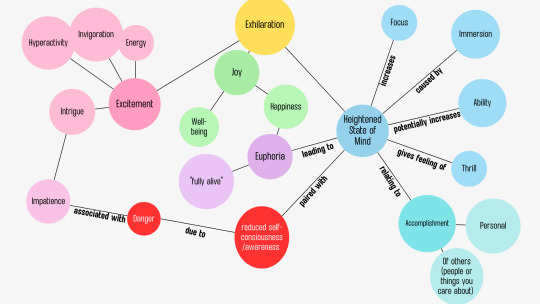
Research - Academic
Definitions of Exhilaration:
Cheerful
Ruch (1990 and 1993, cited in Ruch 1997 p. 1) proposed that exhilaration should be used according to its latin root hilaris, meaning cheerful, to signify the process of entering or fading out of a cheerful state. This contrasts with colloquial use of the term, the “excitement” element is de-emphasised. Ruch proposes that instead of associating exhilaration with happiness or “joy”, it is most strongly aligned with laughter. He states that where empirical studies on happiness rarely report exhilaration, in studies of exhilaration laughter is an inevitable response category.
He discussed exhilarants (situations and stimuli capable of promoting exhilaration) ,the physical and social situational factors, and the actual and habitual organismic factors facilitating or inhibiting the induction of exhilaration. Within this framework, both cheerfulness as a temperamental trait and a mood state were assigned prominent roles. I find this quite confronting as what he’s said makes sense and has merit but I’m so used associating exhilaration directly with excitement and terms such as “invigorate; enliven; stimulate”. Understanding the definition of exhilarating and the reason its variance will help me create an experience that meets the specifications of exhilaration in a comprehensive manner; leaving no one feeling as though they haven’t received what they consider exhilaration.
Research - Creative practice
In the mind map above, I tried to display a number of factors that I believe to be in play in the state of exhilaration in every circumstance. I view these factors as spectrums; thus, in defining difference types of exhilaration I’m inferring that this exhilarating experience may be primarily associated with euphoria and joy, not so much high-energy excitement.
Common States of Exhilaration in Modern Media
Combinations of excitement, intrigue, thrill and accomplishment, are commonly seen in more typical mediums of content such as movies like Avengers: Endgame and basically any movie that has you bouncing in your seat. https://youtu.be/KAIzLj3mYTw (Avengers: Endgame portals opening Audience Reaction)

I recall this moment when I saw this in the cinema and it is certainly an experience I’d describe as exhilarating in the sense that I’ve seen more than 3 previous Avengers films over a number of years and I undoubtedly care about the characters and their goals. The exhilaration was more dependent on long-term narrative development both in and outside of the cinema. I believe that having cliff hangers and being forced to wait for the next movie to come out arguable keeps the story and characters in our mind over a long period of time. I’ve never been a big marvel fan but I’ve no doubt developed that care that’s necessary in providing a highly exhilarating moment in a triumphant/comeback scene like this. I’d say it’s comparable to barracking for a sports team; one doesn’t cheer, cry, or scream their lungs out in cheer or excitement for a team they don’t care about, it’s years of consistent association that creates that experience. From my perspective, the care I felt for the characters in this movie was very much sub-conscious; nonetheless, it was consistent.
A more euphoric state of exhilaration may be characterised by heightened engagement that incites a sense of freedom, joy, nostalgia, and liberation from everyday concerns.
Research - Technical
Character Empathy
I researched methods of creating immediate character empathy to counter the problem underlined above. “The most interesting plot won’t matter to readers if they don’t care about your main character.” (Collins, 2016).
Here are a few that will best suit a potential main character in my project:
Danger
Attempting to overcome a fear or make a change
Facing inner struggle
Display of courage
Unique skill or mindset
Exhilaration predicting subsequent Mood states
“Does exhilaration predict subsequent mood states? Table 4 shows that intensity and duration (but not frequency) of facial indicators of exhilaration predicts subsequent cheerful mood state. Additionally, those who showed more intense exhilaration were also less serious afterwards. Since the intervention contained nonsensical elements it would not be surprising if the degree of state seriousness would be reduced, too. However, this coefficient was not significant (r = .35; d.f. = 27) once the effects of state cheerfulness (post scores) were partialled out. Thus, it is the peak intensity experiences that altered the mood state and less so how often individuals smiled. Intensity (r = .32; p = .088) and duration (r = .42; p = .0190; d.f. = 28) of exhilaration episodes were also correlated with amount of change in state cheerfulness.” (Ruch, 1997).
Flow State - Being “in the zone”
A mental state of full immersion and engagement in an activity; brings on a feeling of energised focus while performing a task. The concept was introduced by Hungarian-American psychologist Mihaly Csikszentmihalyi in his book Flow: The Psychology of Optimal Experience published in 1990. An individual in the flow state experiences heightened concentration, a sense of control, and a loss of self-consciousness such as the passing of time; typically individuals in this state find the activity intrinsically rewarding (Csikszentmihalyi, 1990). There are similarities between this state and the state of exhilaration Although this state is defined as entered when performing a task or activity, I’ve found a similar state to be achievable through mere audio-visual pieces; therefore, it should be even more achievable with an HME.
Exhilarating Project 1 - Video + Sound
No progress yet, in the midst of better understanding exhilaration
Exhilarating Project 2 - Capitol Lighting + Sound
No progress yet, in the midst of better understanding exhilaration
Works cited
Collins, B. (2016) ’10 Ways To Create Immediate Character Empathy’, JerryJenkins, 23 August. Available at: https://jerryjenkins.com/create-character-empathy/
Csikszentmihalyi, M. (1990). Flow: The Psychology of Optimal Experience. Harper & Row.
Ruch, Willibald. (1997). State and trait cheerfulness and the induction of exhilaration: A FACS study. European Psychologist. 2. 328-341. 10.1027/1016-9040.2.4.328.
0 notes